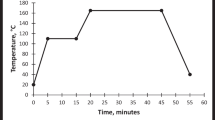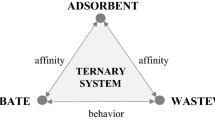Abstract
In this research, the removal of levulinic acid from aqueous solutions was examined by using clay nano-adsorbents, namely montmorillonite and Cloisite 20A. The batch adsorption experiments were exerted at a different contact time (30–210 min), initial levulinic acid concentrations (20–100 g L−1), adsorbent amounts (0.05–0.25 g), and temperatures (25–45 °C). The equilibrium, kinetic, and thermodynamic data were obtained by using the adsorption capacities of clay nano-adsorbents. It was found that Cloisite 20A exhibited a higher adsorption capacity than montmorillonite. Different adsorption isotherm and kinetic models were utilized to explain the adsorption mechanism and the parameters of these models were determined. Moreover, the thermodynamic analysis was performed to express the adsorption process. For the adsorption of levulinic acid on both clay nano-adsorbents, the adsorption equilibrium data were well represented by the Freundlich isotherm model and the adsorption kinetic data were well characterized by the pseudo-second-order kinetic model for the removal of levulinic acid by two clay nano-adsorbents.









Similar content being viewed by others
References
Baylan N, Çehreli S (2018) Ionic liquids as bulk liquid membranes on levulinic acid removal: a design study. J Mol Liq 266:299–308
Caballero B, Trugo LC, Finglas PM (2003) Encyclopedia of food sciences and nutrition. Academic .
Guad R, Surana S, Talele G, Talele MS, Gokhale MS (2006) Natural excipients. Pragati Books Pvt. Ltd.
Kumar S, Babu B (2008) Process intensification for separation of carboxylic acids from fermentation broths using reactive extraction. J Fut Eng Technol 3:19–26
Datta D, Marti ME, Pal D, Kumar S (2017) Equilibrium study on the extraction of levulinic acid from aqueous solution with Aliquat 336 dissolved in different diluents: Ssolvent’s polarity effect and column design. J Chem Eng Data 62:3–10
Long NVD, Lee M (2016) Design and optimization of the levulinic acid recovery process from lignocellulosic biomass. Chem Eng Res Des 107:126–136
İnci I, Aydın A (2003) Extraction of hydroxycarboxylic acids with MIBK/Toluene solutions of amines. J Sci Ind Res 62(9):926–930
Aşçı YS, Dramur U, Bilgin M (2017) Investigation of the separation of carboxylic acids from aqueous solutions using a pilot scale membrane unit. J Mol Liq 248:391–398
Lalikoğlu M, Gök A, Gök MK, Aşçı YS (2015) Investigation of lactic acid separation by layered double hydroxide: equilibrium, kinetics, and thermodynamics. J Chem Eng Data 60:3159–3165
Brouwer T, Blahusiak M, Babic K, Schuur B (2017) Reactive extraction and recovery of levulinic acid, formic acid and furfural from aqueous solutions containing sulphuric acid. Sep Purif Technol 185:186–195
Kim JH, Na J-G, Yang J-W, Chang YK (2013) Separation of galactose, 5-hydroxymethylfurfural and levulinic acid in acid hydrolysate of agarose by nanofiltration and electrodialysis. Bioresour Technol 140:64–72
Datta D, Uslu H (2017) Adsorption of levulinic acid from aqueous solution by Amberlite XAD-4. J Mol Liq 234:330–334
Liu B-J, Hu Z-J, Ren Q-L (2009) Single-component and competitive adsorption of levulinic/formic acids on basic polymeric adsorbents. Colloids Surf A Physicochem Eng Asp 339:185–191
Awual MR, Eldesoky GE, Yaita T, Naushad M, Shiwaku H, AlOthman ZA, Suzuki S (2015) Schiff based ligand containing nano-composite adsorbent for optical copper (II) ions removal from aqueous solutions. Chem Eng J 279:639–647
Baylan N, Meriçboyu AE (2016) Adsorption of lead and copper on bentonite and grapeseed activated carbon in single-and binary-ion systems. Sep Sci Technol 51:2360–2368
Liu BJ, Liu SW, Liu TB, Mao JW (2012) Advanced Materials Research. Trans Tech Publ 1691–1695
Uslu H, Datta D, Santos D, Öztürk M (2019) Separation of levulinic acid using polymeric resin, Amberlite IRA-67. J Chem Eng Data 64:3044–3049
Liu B-J, Ren Q-L (2006) Sorption of levulinic acid onto weakly basic anion exchangers: equilibrium and kinetic studies. J Colloid Interface Sci 294:281–287
Liu B, Liu S (2011) Adsorption of levulinic acid from aqueous solution onto basic polymeric adsorbent: experimental and modeling studies. Sep Sci Technol 46:2391–2399
Lin X, Huang Q, Qi G, Xiong L, Huang C, Chen X, Li H, Chen X (2017) Adsorption behavior of levulinic acid onto microporous hyper-cross-linked polymers in aqueous solution: equilibrium, thermodynamic, kinetic simulation and fixed-bed column studies. Chemosphere 171:231–239
Lin X, Huang Q, Qi G, Shi S, Xiong L, Huang C, Chen X, Li H, Chen X (2017) Estimation of fixed-bed column parameters and mathematical modeling of breakthrough behaviors for adsorption of levulinic acid from aqueous solution using SY-01 resin. Sep Purif Technol 174:222–231
Bhatia D, Datta D, Joshi A, Gupta S, Gote Y (2019) Adsorption of isonicotinic acid from aqueous solution using multi-walled carbon nanotubes/Fe3O4. J Mol Liq 276:163–169
Kyzas GZ, Matis KA (2015) Nanoadsorbents for pollutants removal: a review. J Mol Liq 203:159–168
Liu P, Zhang L (2007) Adsorption of dyes from aqueous solutions or suspensions with clay nano-adsorbents. Sep Purif Technol 58:32–39
Hassani A, Kiranşan M, Soltani RDC, Khataee A, Karaca S (2015) Optimization of the adsorption of a textile dye onto nanoclay using a central composite design. Turk J Chem 39:734–749
Kumar P, Sandeep K, Alavi S, Truong V, Gorga R (2010) Effect of type and content of modified montmorillonite on the structure and properties of bio-nanocomposite films based on soy protein isolate and montmorillonite. J Food Sci 75:N46–N56
Mahmoodi NM, Hayati B, Arami M, Lan C (2011) Adsorption of textile dyes on pine cone from colored wastewater: kinetic, equilibrium and thermodynamic studies. Desalination 268:117–125
Yusan S, Gok C, Erenturk S, Aytas S (2012) Adsorptive removal of thorium (IV) using calcined and flux calcined diatomite from Turkey: evaluation of equilibrium, kinetic and thermodynamic data. Appl Clay Sci 67:106–116
Yang X, Al-Duri B (2005) Kinetic modeling of liquid-phase adsorption of reactive dyes on activated carbon. J Colloid Interface Sci 287:25–34
Yeddou N, Bensmaili A (2005) Kinetic models for the sorption of dye from aqueous solution by clay-wood sawdust mixture. Desalination 185:499–508
Meroufel B, Benali O, Benyahia M, Benmoussa Y, Zenasni M (2013) Adsorptive removal of anionic dye from aqueous solutions by Algerian kaolin: characteristics, isotherm, kinetic and thermodynamic studies. J Mater Environ Sci 4:482–491
Pavan FA, Dias SL, Lima EC, Benvenutti EV (2008) Removal of Congo red from aqueous solution by anilinepropylsilica xerogel. Dyes Pigments 76:64–69
Freitas A, Mendes M, Coelho G (2007) Thermodynamic study of fatty acids adsorption on different adsorbents. J Chem Thermodyn 39:1027–1037
Pradhan N, Rene E, Lens P, Dipasquale L, D’Ippolito G, Fontana A, Panico A, Esposito G (2017) Adsorption behaviour of lactic acid on granular activated carbon and anionic resins: thermodynamics, isotherms and kinetic studies. Energies 10:665
Çelebican Ö, İnci İ, Baylan N (2020) Investigation of adsorption properties of levulinic acid by a nanotechnological material. J Mol Struct 1203:127454
Author information
Authors and Affiliations
Corresponding author
Additional information
Publisher’s Note
Springer Nature remains neutral with regard to jurisdictional claims in published maps and institutional affiliations.
Rights and permissions
About this article
Cite this article
Baylan, N. Removal of levulinic acid from aqueous solutions by clay nano-adsorbents: equilibrium, kinetic, and thermodynamic data. Biomass Conv. Bioref. 10, 1291–1300 (2020). https://doi.org/10.1007/s13399-020-00744-8
Received:
Revised:
Accepted:
Published:
Issue Date:
DOI: https://doi.org/10.1007/s13399-020-00744-8




